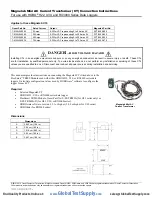
ARTEX PRODUCTS / ACR ELECTRONICS, INC
DESCRIPTION, OPERATION, INSTALLATION AND MAINTENANCE MANUAL
B406-4 (453-5004)
Page 30 of 70
25-62-03
Figure 7 ELT Orthogonal Axes
3)
Keep G-switch loop and 50-ohm load installed on the antenna port from Item 4a installed.
4)
Utilizing the sturdy padded surface, hold the ELT 10 inches (26.1 Centimeters) above the test area and
thrust down forcefully maintaining a level axis into the pad to test the -X axis (see Figure 7).
5)
Repeat step 2 for the -Y, +Y, -Z, and +Z axes (see Figure 7).
6)
Verify in each case that the ELT activates via G-switch trigger as indicated by the flashing LED. An
auxiliary receiver set to 121.5 MHz should be used to detect the ELT signal.
7)
Reset the ELT after each activation by toggling the ON/OFF switch to ON and then to OFF to reset the
ELT.
SUBTASK 25-62-03-750-003
H.
Performance Testing Setup
NOTE:
The ELT software routine logs battery life in 30-second increments. A minimum of 30
seconds is added to the battery usage total each time the ELT is activated and de-activated.
If the ELT is left activated beyond the first 30 seconds, additional time is added in 30-second
increments.
NOTE:
Careful planning of the performance tests is necessary to avoid activating the ELT more
than necessary. Plan the performance testing in a manner that allows tests to be run
concurrently and test equipment settings to be quickly switched from one test to another.
By doing so, the three-minute warm-up requirement can be eliminated from a number of
tests and battery run time minimized to a large extent.
1)
Place the ELT in a container or screen room capable of substantially attenuating RF signals, or the
transmitter power output shall be connected to a suitable dummy load to minimize radiation.
2)
Use the ELT’s own ba
ttery pack as the power source for these measurements. An alternate power
source can be used where lengthy servicing, other than the performance tests, is anticipated.
3)
Ensure that adequate attenuation rated for 406 MHz is installed between the ELT antenna output and
the measurement equipment to prevent damaging input circuitry, if required. At a minimum, the
attenuator should be rated at 30 dB, and 5 watts for a ½-second duration as shown in Figure 8
Performance Testing Equipment Setup on page 31.
















































